Standard treatment of mites for cats is not traumatic: it can be carried out at the veterinary clinic under the supervision of a veterinarian or on your own – at home.
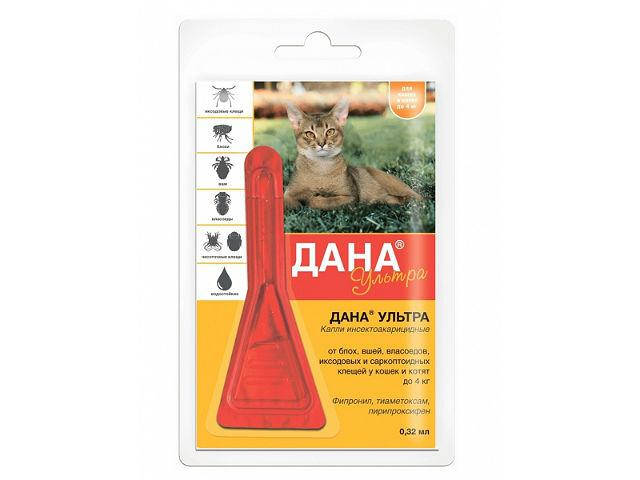
- Cat ear mite – its symptoms and treatment
- Ear mite
- Treat cat ear mites
- The dangers of an ear mite for cats
- Ear mite prevention
- How dangerous otodectosis is
- How is the infection
- Folk remedies for ear mites
- Treatment of a kitten and a pregnant cat
- How to get rid of cat ear mites
- Determine if your cat has ear mites
- Diagnosis
- How to get an initial check-up at home
- Possible complications
- Effective preparations against tick
- What other remedies can be used
- Otodectin
- Ivermec-gel
Cat ear mite – its symptoms and treatment
Cat ear mite is a tiny parasite that causes the animal a lot of suffering and discomfort. Each ear mite has a life cycle that lasts about three weeks. They can cause irritation and inflammation and can lead to infection of both the outer ear and the inner ear canal.
There are several different types of ear mites that parasitize cats, but the most common is Otodectes cynotis. These are mites that feed on the oils and wax in the animal's ears. The parasites cause a serious disease called otodectosis. To relieve the animal from suffering, it is important to react in time and begin treatment.
Ear mite
The cat ear mite is a tiny living arthropod. The parasite manages to molt (shed its coarse shell) several times before sexual maturity. The microscopic jaws firmly dig into the skin and suck out the intercellular fluid.
Many owners have the question, is cat ear mite not transmissible to humans, or is it? In fact, the parasite poses no danger to humans. Cat ear mites are dangerous for dogs, hamsters, decorative rabbits. They also settle in the animal's ears and cause great discomfort.
Medicines for cat ear mites will prescribe a veterinarian after diagnosis. The main thing is to contact a specialist in time, because untimely treatment can lead to a deterioration of the pet's hearing.
Also learn about skin mites in cats , the symptoms of its presence and the order of treatment.
Treat cat ear mites
Cat ear mites (Otodectosis)
The causative agents of otodectosis in cats are microscopic mites that live in the ear canal, feed on skin debris and are very fond of a moist environment. The mites multiply quite quickly, so if you notice any of the following symptoms, take action immediately.
– Itching is the main symptom of otodecosis in cats. And the itching is so severe that the animal becomes restless, constantly scratching his ears, shaking his head and often hurts himself while scratching. This is an additional problem because some infection can easily attach to it as well. In advanced cases, the animal's hair starts to fall out at the site of the lesion.
– An accumulation of dark brown discharge, which has an unpleasant odor
Ticks from the ears can also spread throughout the animal's body. Ticks also affect all animals that have come in contact with the diseased animal, so keep this in mind when treating your pets. It is almost impossible for a human cat to catch an ear mite.
Only a veterinarian can prescribe adequate treatment after a proper diagnosis. Therefore, self-treatment is not recommended, as you may start treating the wrong disease.
Once you have a veterinarian's prescription, strictly follow the dosage of the medicine and the regularity of treatment manipulations. Remember that you should not stop treatment immediately after the symptoms of the disease disappear, as this can lead to reinfection.
– Drip a few drops of an antiseptic
-With cotton swabs, remove any accumulated secretions as much as possible
– drip 3 to 4 drops of Bars or Amitrazine for 7 days
– Continue to clean the ear canals with cotton swabs
Start by flushing your pet's ear with tea. Green tea is a natural antiseptic that helps remove "tick dirt from the ear canal," says the doctor. Infuse one teaspoon of dried green tea in a cup of hot water for three to four minutes, strain, cool at room temperature. Using a small dropper, flush the animal's ear canal with the tea. Massage the outside of the ear to allow the tea to spread inside, and wait. When the animal starts to shake its head, the tea, along with the dirt, will fly out. Then wipe the outside of the ear canal with a piece of cloth or cotton swab, the doctor says. For sure treatment of cat ear mites, do this procedure once a day for a month.
The dangers of an ear mite for cats

The mite itself is not dangerous to cats and delivers discomfort in the form of itching. The greatest danger comes from infections that join the disease in the process. Because of scratching in the ears, bacterial, viral or fungal inflammation develops, which leads to decreased hearing, pain, and perforation of the eardrum. The infection moves deeper into the ear, reaches brain tissue, and results in death from meningitis. Deafness and death of the pet ends in 10% of cases.
Ear mite prevention
In order not to treat ear mite in cats, it is important to carry out prevention in time – to treat the pet with drops against external and internal parasites. There are also other forms of drugs – collars and sprays.
Depending on the form of the drug, treatment should be carried out monthly or once a quarter. Prevention is important for cats regardless of whether they go out for a walk, since parasite eggs can easily be brought in on shoes.
Most often used for treatment drops: "Selafort", "Bravecto", "Frontline", "Inspector", "Advocaat", "Bars", "Dana". Drugs vary in price and duration of action – from a month to a quarter.
Disadvantages of drops: you need to look for a suitable drug – not all drops cats tolerate equally well, itching or anxiety may appear: the pet may not like the smell of the drug. In such cases, choose means of prolonged action: drops "Selafort" or "Bravecto". This allows you not to bother your four-legged friend every month, but once every three months.
A collar may protect your cat from parasites for up to 240 days. The duration of protection is balanced by the disadvantages: not all cats are disposed to wear such an accessory. It can cause allergies and is especially not recommended for animals that are let out on their own. If the pet gets caught on an obstacle, the gadget will cause strangulation.
It is important to treat both male and female cats before mating: most ear mite prevention and treatment products are not used for kittens until eight weeks of age.
How dangerous otodectosis is

Otodectosis or ear scabies is an inflammation of the skin of the ear canal caused by an ear mite infestation in cats.
It is almost impossible to track the beginning of the disease in a cat without a magnifying device: adult mites grow to 0.2-0.8 mm, so a cursory visual examination will go unnoticed. To diagnose otodectosis you should visit a veterinary clinic, have a scrape of the ear canal and wait for the results under a microscope.
Further development of the disease is fraught with the accession of an allergic reaction and insemination of discharges from the ear with secondary microflora. For example, staphylococcus, fungi, or other flora. In an attempt to clean the ears on its own, the cat injures the skin with its claws. Inflammation, eczema and dermatitis develop where the scratches occur.
As a result, prolonged illness can lead to fever, ruptured eardrums and otitis media in the middle ear of the cat. This, in turn, leads to hearing loss, inflammation of the brain membrane and death.
How is the infection
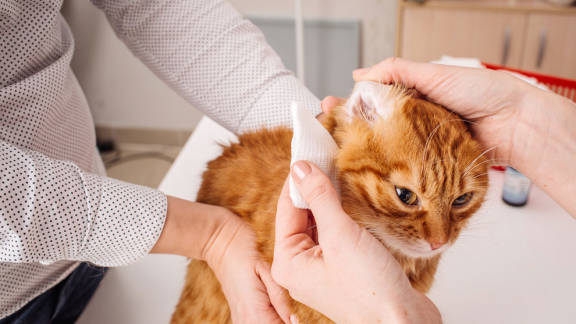
An ear mite infestation occurs in two ways: through contact with an infected surface or through the body or clothing of the host. Carriers of the mite can be other furry animals (not necessarily cats), humans, flies and fleas.
Ear mites tend to live in moist and warm environments. Therefore, when they get on the animal's fur or skin, they try to get into the ears. And only in the severe stage of the disease can ear mites be found on the neck, abdomen or tail of the pet.
To fall ill with an ear mite it takes only a few seconds. In this case, the first symptoms of infestation do not occur immediately. Usually the cat becomes ill several weeks after the first contact.
Folk remedies for ear mites
Folk remedies are recommended for use only at the initial stage of infection, for prevention or as an auxiliary method of treatment. To clean the inner surface of the auricle of crusts and scabs, you can use ordinary sunflower oil as well as camphor or Vaseline oil. You will need cotton pads for the treatment. Excess oil should be blotted out.
A 3% hydrogen peroxide solution can be used for disinfection. The cotton disk should only be slightly moistened in the product and gently wipe the infected area with it. At the same time you should make sure that the peroxide does not run deep.
Strong green tea infusion will do as an antiseptic – a dessert spoon for half a cup of boiling water. The warm liquid should be wiped over the ear lobes with a cotton swab.
Garlic is an excellent antiseptic, but do not use it in its pure form to treat the ear cavities of the pet – it may provoke even more irritation of the problem area. A mixture of 2 tablespoons of vegetable oil and half a clove of crushed garlic may be used in the complex treatment of otodectosis. The composition is kept for 24 hours in a dark and warm place, and then strained.
If several pets live in the house, you need to protect them from contact with the sick animal, as well as treat for prevention.
Treatment of a kitten and a pregnant cat
Choose preparations for the therapy of otodectosis very small kittens and pregnant cats should be more carefully. You can call folk remedies completely safe, but they will only help in mild, untreated forms of the disease. Looking at a range of industrial drugs should choose those that are not absorbed into the blood.
Approved for use in pregnant cats Stronghold, which is applied once. It is low-toxic and, if the dosage is followed, is absolutely safe. It is also approved for use in kittens from 6 weeks of age. For babies, you should choose drops in a package of lilac color, and for adults – blue.
Another safe treatment for ear scabies in pregnant and nursing females is Frontline Spot On. It does not enter the animal's bloodstream but is distributed in the epidermis and sebaceous glands. For kittens from the first days of life, you can use Frontline Spray.

Choose drugs for the treatment of ear scabies in kittens should be carefully – some of them can cause harm to a furry baby
How to get rid of cat ear mites
wikiHow operates on a wiki basis, which means that many of our articles are written by multiple authors. When this article was created, 23 people(s) worked on editing and improving it, including anonymously.
Number of sources used in this article: 13. You will find a list of them at the bottom of the page.
Ear mites are microscopic spider-like insects that live on the skin or in the ear canals of cats. [1] X Information source Reaginic hypersensitivity in Otodectes cynotis infestation of cats and mode of mite feeding. Powell et al. Am J Vet Res 41 (877). Ear mites can cause severe ear irritation and itching. Infected cats may constantly scratch their ears, scratching them. The most common complications are skin infections. If you notice similar symptoms in your cat, use the steps below to get rid of ear mites.
Determine if your cat has ear mites
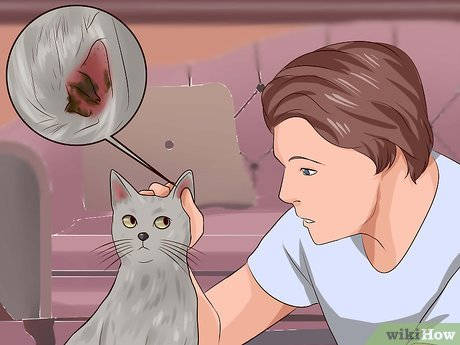
- If your cat is healthy, you will see very little wax in the ears. Mite-infected ears usually have a black plaque that looks like crushed coffee beans. [3] X Reliable source American Society for the Prevention of Cruelty to Animals Go to source
- The wax serves as a protective coating against possible contamination.
- You may also notice a foul odor coming from the cat's ears.

- The cat can damage the top layer of the skin, resulting in even more soreness, bleeding, and in some cases, the development of bacterial infection. [5] X Source of information Small Animal Dermatology. Muller & Kirk. Publisher: Saunders.
- A cat suffering from ear mites for a long time may develop inflammatory polyps in the ear canals, as well as bloody blisters from constant scratching. [6] X Source of information Elaine Wexler-Mitchell, A Healthy Cat., p. 174, (1999), ISBN 1-58245-057-9
- In addition, the outer ear may be inflamed and festering. The cat may also damage its eardrum. In this case, professional medical attention is required. [7] X Merck/Merial information source, The Merck/Merial Manual for Pet Health, p. 501, (2007), ISBN 978-0-911910-99-5
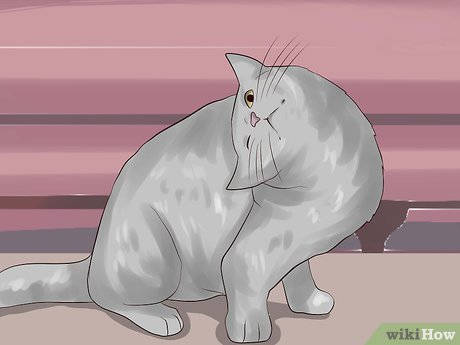
Diagnosis
In order to make an accurate diagnosis you must undergo an examination: go to a veterinary clinic and take a scraping of the ear for further clinical and laboratory examination.
It is impossible to find an ear mite without a magnifying device, but an examination with an otoscope and a microscopic result are necessary.
If otitis externa is suspected, further testing is needed to determine the composition of the microflora and to guide further treatment.
Many of the symptoms that signal an ear mite infection also apply to other diseases. For example, yeast infection. Therefore, the self-prescription of drugs with antiparasitic components is not allowed. They can distort the clinical picture: lead to an incorrect diagnosis or complicate the course of the disease.
How to get an initial check-up at home
To check your pet at home, you will need a cotton swab or long tweezers wrapped in a bandage, a piece of black paper, and a magnifying glass:
Step 1. Gently run the cotton swab along the inside wall of the ear canal, without going into the ear canal.
Step 3. Examine the secretions with a magnifying glass. Scabies ear mite in cats looks like a whitish moving dot.
If you notice traces of the parasite, make an appointment with a veterinarian: the specialist will make a treatment plan and choose effective medications corresponding to the age of the pet, the peculiarities of its health and the stage of the disease.
Please note: if the ear mite is joined by a secondary infection, and the ears are festering, you will not be able to see the parasites.
Possible complications
Upon detection of the first signs of infection, it is recommended to remove the ear mites as soon as possible. Otherwise, complications can develop:
The saddest thing that can happen is the death of the cat. It can be fatal if the inflammation spreads to the brain membrane.
It can be difficult to remove ear mites if the disease is neglected, so it is important to pay attention to the behavior of the cat. If she became restless and a dark mass appeared in the ears, it is better to immediately seek veterinary help and begin treatment.
💡 A side note. More than half of your pet's health issues can be resolved remotely: over the phone or through online correspondence. At Veterinarian Online, you can get a consultation with a specialist, quickly and without having to go to a veterinary clinic. The cost of the service: 399 rubles.
Effective preparations against tick
Cat ear mite drops are used most often as they are fast-acting and easy to use. An effective product for the pet of any age can be selected.
Drops are buried in the ears or applied to the withers. The range of drugs in this dosage form is large.
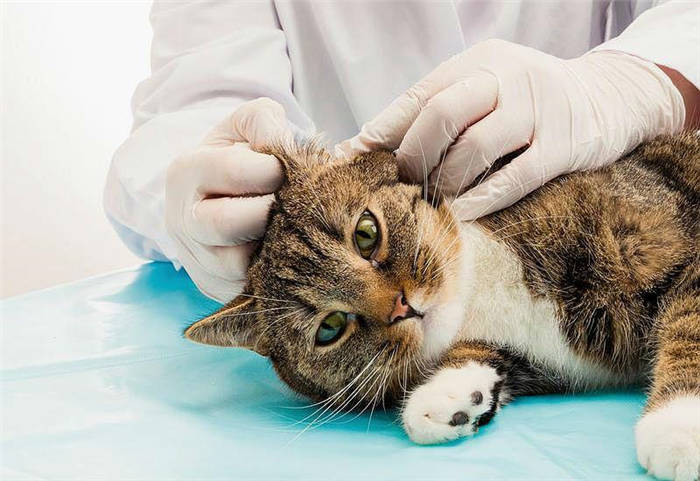
Important! Cat ear mite medicine blocks the nervous system of the parasite. Then the mite's motor activity is disturbed, and after some time it is paralyzed, after which it dies.
The decision on the choice of drug form is made by the veterinarian after laboratory diagnosis.
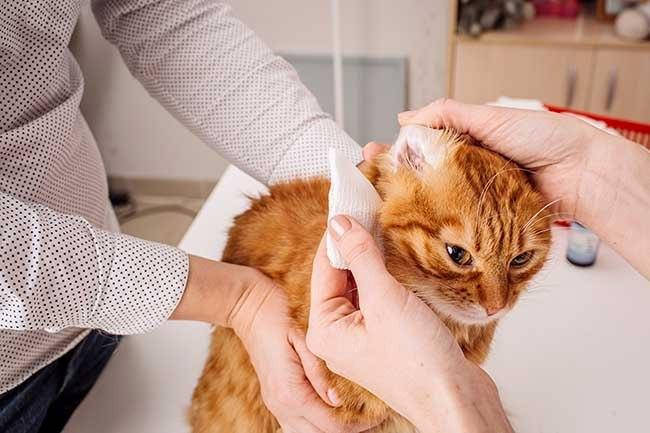
The ear mite drug is injected into 2 ears, even if only one is affected. If the dose is exceeded, the cat is observed abundant salivation, trembling in the muscles, vomiting.
The only contraindication is an allergy to the components of the drops. Then the animal secretes a large amount of salivary and tear fluid, irritation on the skin appears. In this case, the solution is washed off, and the animal is given antihistamines.
During the treatment of the ears of an infected cat, the following rules of prevention should be observed:
- During the application of ear drops, it is forbidden to smoke, eat or drink.
- After the application of the product it is necessary to wash hands with soap and water.
- Do not pet the animal for 2-3 days after applying the solution.
- If the drops get on mucous membranes or skin, they should be rinsed with plenty of water.
- Allergic persons should not come into contact with the drug.
If symptoms of allergy appear in a person, you need to consult a doctor. You need to take the instructions for the drug with you.
What other remedies can be used
Medicines for the treatment of ear mite are presented in different forms:
- Solution for injections are injected subcutaneously. It quickly shows the therapeutic effect rarely causes adverse reactions.
- Mite gel is applied to the affected areas of the ear in a thin layer. It is practically not absorbed into the bloodstream, acting on the surface of the skin.
- The spray is used to treat the inner surface of the auricle after cleaning the ear canal of crusts. It is used for kittens over 7 weeks of age.
- Liniment is a liquid ointment for ear mites. It is injected into each ear with a dropper. The ointment is applied in a thin layer using a special spatula.
The decision about the most suitable dosage form for a sick cat should be left to the veterinarian.
Otodectin
This is the most effective remedy for the treatment of ear mites in cats. It is presented in the form of a solution for injection. The composition includes ivermectin, isopropanol, triethylene glycol.
The drug is used for helminthiasis, tick lesions (including otodectosis), infestation with fleas, louseflies. It is effective against larvae and sexually mature individuals. The drug destroys the chain of nerve impulses, this leads to paralysis and death of the ear mite.
Otodectin acts faster than drops, the therapeutic effect lasts for 2 weeks. The solution is easily tolerated by cats, there are no adverse reactions if the dosage is observed. The drug is contraindicated in hypersensitivity to components, infection, exhaustion, under 2 months of age.
Otodectin is injected subcutaneously into the forearm or shoulder joint from behind. Standard dose in case of ear mite exposure is 0.2 ml/kg. The frequency of application is 2 times with an interval of 8-10 days.

Ivermec-gel
The drug based on ivermectin, lidocaine, panthenol and other components is used to kill the ear mite at different phases of development. The components of the gel disrupt the transmission of the nerve impulse of the pests, leading to its death. It also accelerates tissue regeneration, pain relieves, eliminates itching.






